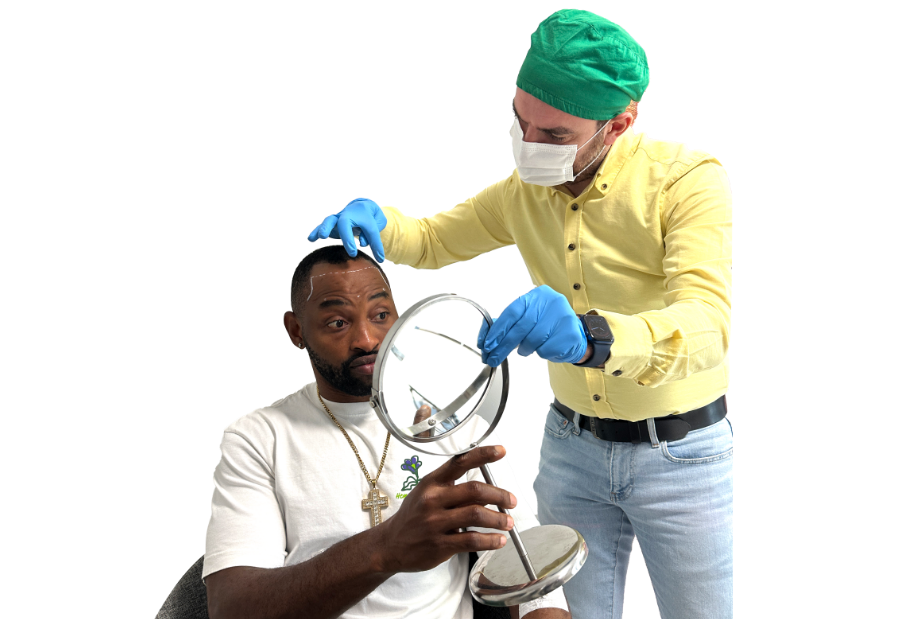Get 25% OFF Hair Transplant Packages This New Year — Book Today!
What are the advantages of DHI hair transplantation?

In today’s age, baldness is common in men and women. As the individual starts losing hair, he will appear older. He or she will also be conscious about the overall appearance. But, mostly, hair loss can be treated through different methods. So, read through to know why you must undergo a DHI hair transplant.
The approach is Minimally Invasive
When the medical specialist carries out DHI (Direct Hair Implantation), he doesn’t have to make large incisions. Instead, he extracts the hair follicles using a pen like device. This ensures precision and reduces the risks of complications. As a result, an individual doesn’t have to bear the trauma. Moreover, the approach is safer and less painful even for male pattern baldness treatment.
DHI doesn’t leave behind visible scars
Soon after someone has undergone DHI, it doesn’t leave behind visible scars. The hair transplant is quite different from the conventional methods. In case the medical specialist considers a conventional method, then he will be busy obtaining strips. This can leave behind scars which are prominent. Way ahead, the healing process is swift soon after DHI. The individual’s appearance will not be ruined due to permanent scars.
The technique offers natural results
As the medical professional ensures precision with DHI, it can help mirror a natural-looking hairline. As the follicles are implanted directly, the method can mimic natural hair growth pattern. Soon after the technique is implemented, it would seem that the individual has natural hair. The person’s scalp will appear as if hair has grown naturally.
There’s No Downtime with the approach
Once hair transplantation ends, the patient can resume work. This means that he can carry out the daily activities as it was earlier. However, the individual will have to bear minor swelling and some redness. Even then, the effects subside within a couple of days. Hence, DHI is a suitable option for those who want to restore hair with less disruption.
How does DHI differ from other hair transplant approaches?
When the surgeon performs DHI hair transplantation, channels are not opened. The patient will also be happy with the natural looking results post surgery. But, with the FUE technique, the hair follicles are extracted one after the other. They are then placed meticulously in the opened channels. Before placing these, they are kept aside for some time. As incisions are made during the male pattern baldness treatment, the person will get affected due to injuries.
With time, people opt for DHI hair transplant for restoring the scalp’s front section. Surgeons are also able to place the grafts with ease in the frontal region. Additionally, the DHI technique gathers the hair strands using 0.80-0.85 mm micro punches. But, while transplanting the grafts, a 0.90 mm DHI Choi pencil is used. On the other hand, you will observe the use of a 1.5 mm Sapphire blade during Sapphire FUE. Above, the DHI technique enables the doctor to place 55 to 60 grafts for every one cm square. In contrast, 35 to 40 grafts can be placed through the FUE technique.
As far as the success rate is concerned, it is 7- to 85% with the Sapphire FUE technique. But, the hair restoration can mostly be achieved through the DHI technique. This is because the success rate is 95 to 98%.
FUE vs. DHI Hair Transplant
Now, let’s check how FUE can differ from DHI. We have presented the differences in the form of a table.
Aspect |
FUE (Follicular Unit Extraction) |
DHI (Direct Hair Implantation) |
| Extraction Method | In this method, hair follicles are individually extracted. | Hair follicles are extracted similarly to FUE. But, these are directly implanted into the scalp. |
| Implantation Process | Follicles are stored temporarily in a solution before implantation. | Follicles are immediately implanted using a Choi implanter. |
| Precision | Assures high precision in follicle extraction. But, this needs skills for implantation. | Assures higher precision in implantation through an implanter pen. |
| Recovery Time | Usually, the recovery is faster than conventional methods. | Similar recovery time to FUE, but may involve less discomfort post surgery. |
| Suitability | Suitable for patients with larger areas of hair loss. | Ideal for patients with receding hairlines
in localized areas. |
| Procedure Time | Can take several hours depending on the number of grafts needed. | May take slightly longer than FUE. |
| Cost | This method is more affordable than DHI. | Generally, this method is more expensive than FUE. This is because of the advanced technology. |
| Natural Appearance | Better results, but requires requisite skills. | Often results in a more natural appearance due to precision. |
Can I Thicken My Hair Without a Transplant?
You can certainly make your hair thick without a transplant. In that case, you can use some non-surgical methods to thicken your hair. By using minoxidil, you can promote hair growth and density. On the other hand, intake of nutrient-rich foods can also help. With time, you must also consider using hair-thickening products. But, while you aim at making your hair thick, you must avoid certain styling practices. To know what will work for you, consider consulting a hair specialist.
Who Can Get a DHI Hair Transplant?
A DHI hair transplant is ideal for those who experience hair loss. In case the individual is bald to a moderate extent, then he or she must opt for a DHI hair transplant. But, before proceeding with DHI, the donor must be chosen wisely. Apart from good health, the donor should not have any scalp conditions. However, it’s better to consult an experienced hair transplant specialist. After speaking with the specialist, you will know if DHI is good for you or male pattern baldness treatment.
DHI Hair Transplant Prices
The price of a DHI hair transplant can vary based on many factors. In case the surgeon has a wealth of experience, then the price can be on the higher side. Moreover, the price can differ depending on the number of grafts that are required. But, it’s worth investing in a DHI hair transplant. This is because it is known for precision and it offers natural looking results. People still opt for DHI hair transplant even when it’s more expensive than other methods.
How is DHI Hair Transplantation Performed?
Generally, DHI hair transplantation is performed using a DHI implanter pen. First and foremost, the medical professional extracts the hair follicles. As you proceed, he will extract the follicles from the back of the scalp. Afterward, he will load the follicles carefully into the implanter pen. Soon after loading, he will directly implant the follicles. But, when he is doing the implantation cautiously, he will place them at an angle. This will thus, ensure natural hair growth and precise results. Ultimately, minimal scars will be observed on the patient’s scalp.

